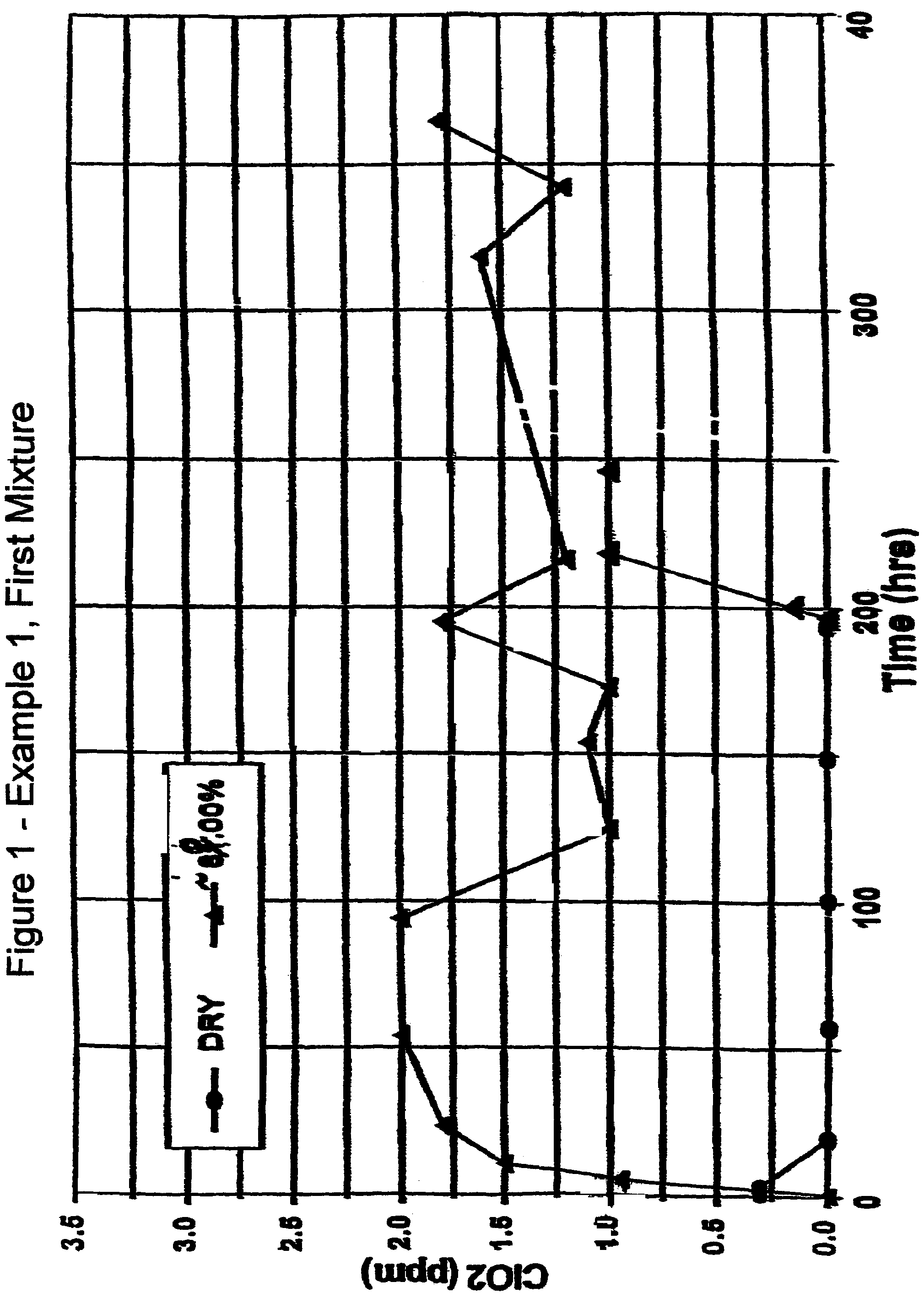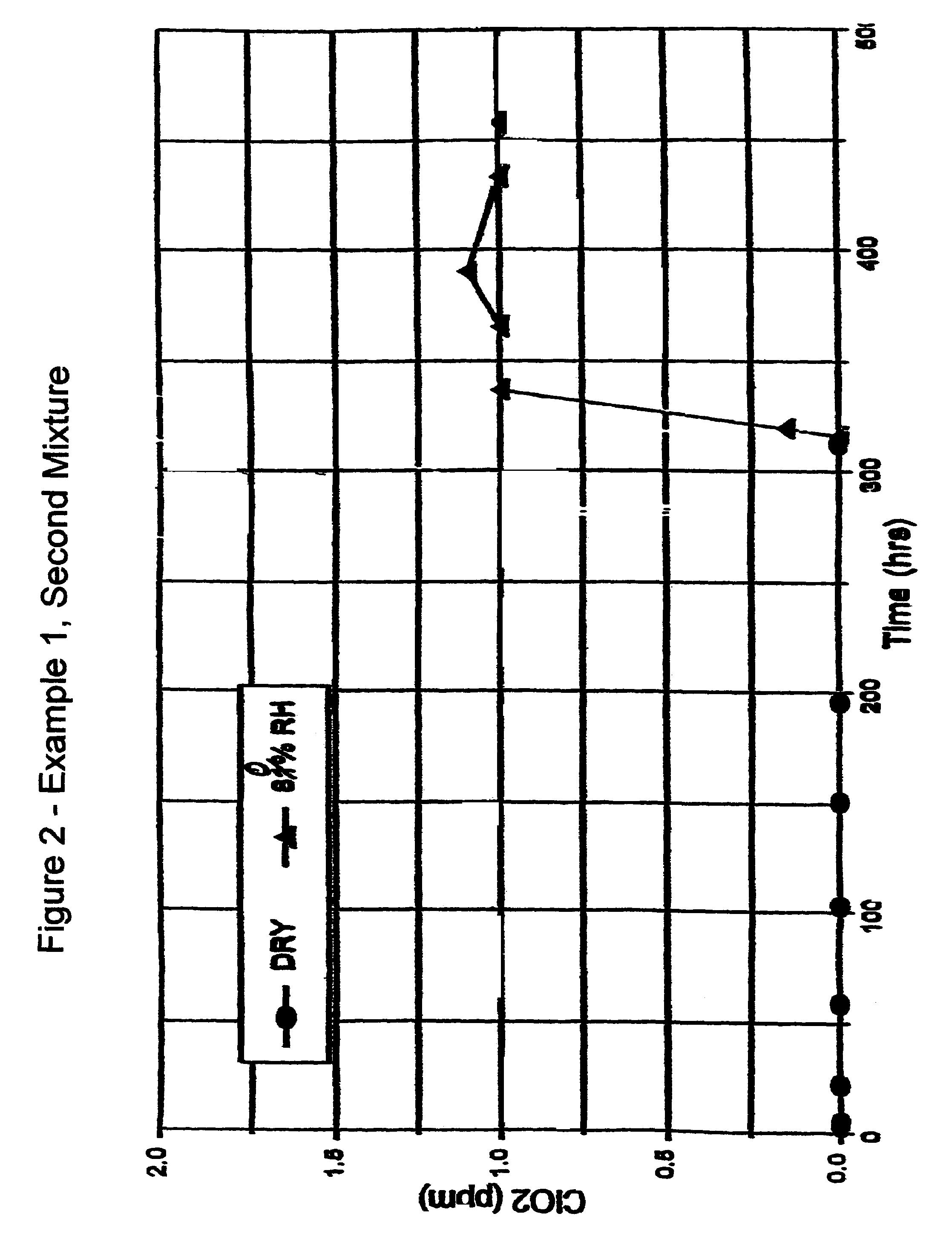Method and system for the controlled release of chlorine dioxide gas
a technology of chlorine dioxide gas and controlled release, which is applied in the direction of halogen oxide/oxyacids, other chemical processes, separation processes, etc., can solve the problems of limited use of chlorine dioxide in large commercial applications, the conventional method of on-site manufacture requires not only expensive generation equipment, but also high operator skill levels
- Summary
- Abstract
- Description
- Claims
- Application Information
AI Technical Summary
Benefits of technology
Problems solved by technology
Method used
Image
Examples
example 1
[0072]First Mixture: 200 grams of metakaolin microspheres prepared as in Preparative Example IV were mixed with 12.5 grams of dried sodium chlorite prepared as in Preparative Example I with mild hand grinding with a mortar and pestle under ambient room air conditions. The mixed sample was placed in a sealed glass jar wrapped with opaque tape.
[0073]Second Mixture: 200 grams of metakaolin microspheres were mixed with 12.5 grams of dried sodium chlorite with mild hand grinding with a mortar and pestle under dry air conditions at a dew point below about −20° C. in a glove bag. The mixed sample was placed in a sealed glass jar wrapped with opaque tape.
[0074]One gram of the First Mixture was tested under dry conditions as described in the Test Procedure. The results are shown in FIG. 1. An initial trace (0.3 ppm) of chlorine dioxide gas was detected over the first five hours which was probably due to water initially present in the sample, but no further chlorine dioxide gas was detected t...
example 2
[0078]A. 200 grams of spinel phase microspheres prepared as in Preparative Example V were mixed with 12.5 grams of dried sodium chlorite with mild hand grinding with a mortar and pestle under ambient room air conditions. The mixed sample was placed in a sealed glass jar wrapped with opaque tape.
[0079]B. One gram of the mixture prepared as in paragraph A above was tested at about 80% relative humidity. Chlorine dioxide gas was first detected after 5.5 hours. The concentration of chlorine dioxide gas peaked at 1 ppm after 94 hours, and the concentration of chlorine dioxide gas was 0.15 ppm after 364 hours.
example 3
[0080]A. Acid activated bentonite clay was prepared as follows. A slurry was prepared containing Engelhard F100™ brand bentonite clay and oxalic acid (1 gm clay / 10 ml of 2 M oxalic acid solution). The slurry was heated to 90° C. for 6 hours, filtered, washed 3 times with deionized water, dried at 105° C., and then calcined for 3 hours at 350° C.
[0081]B. 50 grams of acid activated bentonite clay prepared as in paragraph A above was mixed with 3.2 grams of dried sodium chlorite with mild hand grinding with a mortar and pestle under dry air within a glove bag. The mixed sample was placed in a sealed glass jar wrapped with opaque tape.
[0082]C. The mixture prepared as in paragraph B above was tested as described in the Test Procedure. Under dry conditions no chlorine dioxide gas was detected after 72 hours of testing. Under humid conditions a trace (0.1 ppm) of chlorine dioxide gas was detected after 5 hours; the concentration peaked at 2.5 ppm after 45.5 hours, and was at 2.25 ppm after...
PUM
| Property | Measurement | Unit |
|---|---|---|
| particle size | aaaaa | aaaaa |
| temperature | aaaaa | aaaaa |
| flow rate | aaaaa | aaaaa |
Abstract
Description
Claims
Application Information
 Login to View More
Login to View More - R&D
- Intellectual Property
- Life Sciences
- Materials
- Tech Scout
- Unparalleled Data Quality
- Higher Quality Content
- 60% Fewer Hallucinations
Browse by: Latest US Patents, China's latest patents, Technical Efficacy Thesaurus, Application Domain, Technology Topic, Popular Technical Reports.
© 2025 PatSnap. All rights reserved.Legal|Privacy policy|Modern Slavery Act Transparency Statement|Sitemap|About US| Contact US: help@patsnap.com



